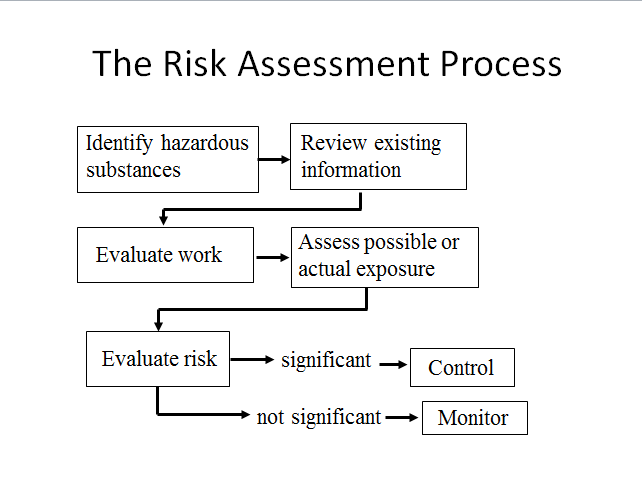5. Risk Assessment
Risk Assessment Presentation
Hazard and Risk Key Points
Risk assessments are a means of determining how likely something will cause harm and what actions need to be taken to protect against that harm.
In a risk assessment the hazard is anything that might cause harm. When identifying the hazard we will consider things such as physical form (e.g. a fine dust) and the possible health effects that might occur from exposure to the hazard (e.g. lung cancer). The hazard we are considering in this course is respirable crystalline silica which is a very fine dust and, if breathed in, can cause a range of health effects such as fibrosis and lung cancer.
The risk in a risk assessment is the likelihood that exposure to RCS will cause fibrosis, lung cancer or any of the other diseases previously discussed.
Assessment of Risk
The assessment will take into account factors such as the duration and level of exposure to determine the level of risk of contracting disease. Having assessed the level of risk the risk assessment it will then be possible to identify suitable means of reducing it to an acceptable level.
Occupational Exposure Limits
Risk assessments for the exposure to hazardous substances will often compare the duration and level of exposure to an occupational exposure limit (OEL) as a means of assessing the level of risk. An OEL is an acceptable upper limit of the concentration of a substance in the workplace air. These limits are generally set and enforced by national authorities and may be given different names such as the US NIOSH REL and the UK HSE WEL. It should be noted that the OEL relates concentration of the hazardous substance in the air that worker is breathing in (personal exposure) and the average concentration over a specified period of time (normally an 8 hour Time Weighted Average for substances that have chronic or long-term health effects). The OEL for RCS varies from country to country. Examples of RCS OELs include 0.025 mg/m3 (ACGIH TLV), 0.05mg/m3 (NIOSH REL) and 0.1mg/m3 (HSE WEL) for an 8 hour TWA exposure. It should be noted that exposure at the OEL will not protect all of the exposed workers from contracting disease. Exposure should always be kept below the OEL and as low as possible.

The Risk Assessment Process
There are a number of steps in the risk assessment process. These are summarised in the diagram below.

Existing information from previous assessments or from information in the literature about the process may provide a useful starting point of a new assessment. This information may indicate whether or not significant levels of exposure to RCS had been previously found in similar circumstances. In many cases relevant existing may not exist and visual indicators of potentially high levels of exposure may be seen in the workplace. These include deposition of dust on work surfaces and visible dust clouds. It should be noted that concentrations of RCS dust at or below the OEL will not be visible under normal lighting conditions. The use of a dust lamp may help to visualise these dust clouds. A risk assessment will use existing information, observation of the workplace, and, if appropriate, measurement of exposure to make a judgement about the level of risk and what actions need to be taken to reduce the level of risk to an acceptable level.
Complete the sentences below to test your understanding of risk assessment.
Enter the missing word into the sentence below.
Read the sentence below and fill in the missing word.
Enter the missing words in the sentence below.
Read the sentence below and fill in the missing words.
Enter the missing words into the sentence below.
Read the paragraph below and fill in the missing words.